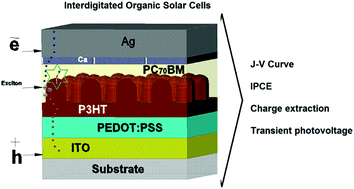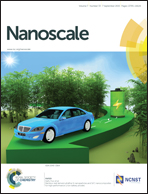Design, fabrication and charge recombination analysis of an interdigitated heterojunction nanomorphology in P3HT/PC70BM solar cells†
Abstract
In this work interdigitated heterojunction photovoltaic devices were manufactured. A donor layer of P3HT nanopillars was fabricated by soft nanoimprinting using nanoporous anodic alumina templates. Subsequently, the PC70BM acceptor layer was deposited by spin coating on top of the P3HT nanopillars using a solvent that would not dissolve any of the previous material. Anisole solvent was used because it does not dissolve the bottom donor layer of nanopillars and provides a good wettability between the two materials. Charge extraction was used to determine the charge carrier densities n on the interdigitated heterojunction under operating conditions. Moreover, transient photovoltage measurements were used to find the recombination rate constant in combination with the charge carrier density. At the same time, the interdigitated structure was also compared with bulk heterojunction and bilayer solar cells manufactured with the same polymeric and fullerene materials in order to understand the recombination loss mechanisms in the ordered and disordered nanomorphologies of the active layers.


 Please wait while we load your content...
Please wait while we load your content...